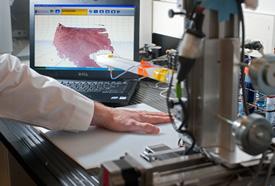
A normal inkjet printer could give you a new patch of skin and help save the lives of burn victims everywhere. Researchers at the Armed Forces Institute of Regenerative Medicine (AFIRM), working with Wake Forest Institute for Regenerative Medicine (WFIRM), recently announced that they have success printing skin onto mice to heal wounds. According to Reuters, the team has also successfully mounted a skin-printer onto an assembly that could fit over a hospital bed. This system could revolutionize the treatment of soldiers injured in war, burn victims, or anyone that needs to heal after the loss of skin. Check out a video of the AFIRM skin-printing lab from LabTVOnline after the break.
It wasn’t that long ago that we were marveling at Wake Forest’s use of an inkjet to print organs and it was just in December that we saw Organovo announce the sale of the first commercial research bioprinter. However, constructing 3D organs one layer at a time is a complex endeavor, especially with the different cells and tissue types needed. Organovo, for the moment, has focused on blood vessels which are simpler to construct than kidneys and livers. It may take a long time before we find organ bioprinters in hospitals, but skin-printing seems like it might be here much sooner. The tissue is flatter, uses just two main types of cells, and has an application in high-demand: helping burn victims.
LabTVOnline got some great access to the skin-printing lab, though the narration does approach the subject from a very basic level:
The WFIRM/AFIRM team announced it’s latest successes with skin printing at the recent Translational Regenerative Medicine Forum. Tests on mice found that printed skin would heal mouse wounds weeks faster than normal. According to Reuters, the skin printer complete closed the gap left when a plug of mouse skin was removed in just 3 weeks, versus the 5 weeks the mouse would take to heal on its own. The next step for the team is to work with pigs, whose tissue more closer resembles our own.
In skin-printing, the surface wound is scanned via laser to provide an exact topography of the area. Then, fibroblasts and keratinocytes are applied as necessary to fill the damaged area. Those cells have to be collected from somewhere. Burn victims don’t have a lot of extra skin nor the time to wait for their cells to be cultured. This means that if skin-printing technology is ever to be used in the field, it will likely necessitate donor cells. It’s unclear whether those donated cells would come from cultured skin cells (as they do now in the research phase) or if multipotent stem cells could be used to culture a large number of fibroblasts and keratinocytes. In either case, donor matching may become an issue, limiting effectiveness.
One of the best current biotech solutions for surface damage are acellular matrices like those made by Cook Medical. Derived from pig intestine, they don’t have rejection issues and they promote the body’s own cells to grow through the matrix and heal. Until skin-printing is developed further (and tested thoroughly in humans) it won’t be clear if bioprinting or matrices offer more advantages to the patient. I could really see this going either way.
Even without knowing if bioprinting will be the best solution for replacing damaged skin tissue, we should still develop it as rapidly as possible . 10% of all war casualties involve burns and there are thousands of burn victims in the US every year. Many more need to have some skin replaced after surgery, or surface injury. Heck, anyone on a bicycle would probably want one of these things in their home. We need multiple new solutions available to these patients so that treatment can continue to improve. For its part, skin-printing would allow doctors to apply a living patch to those wounds with single cell precision, speeding recovery and reducing scarring. That’s a powerful incentive to get this form of bioprinting out of the lab and into the field as soon as possible. Let’s hope it happens quickly.



